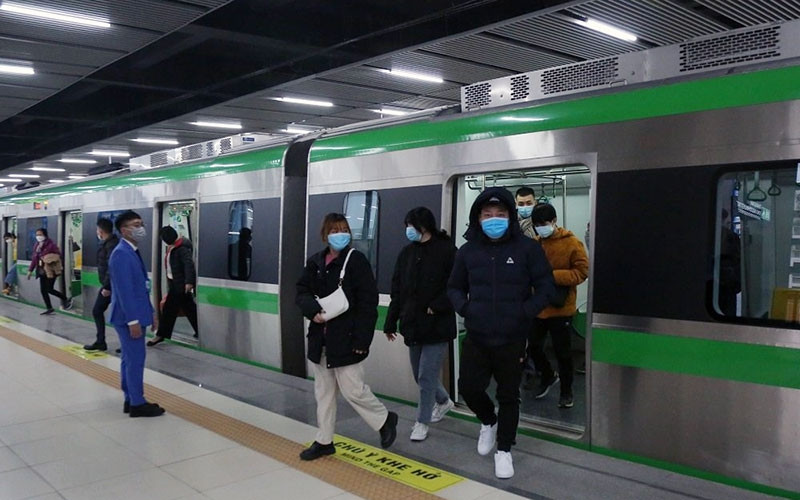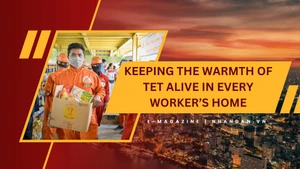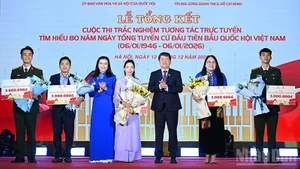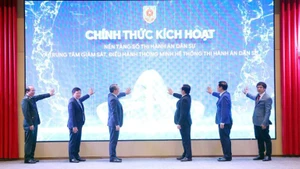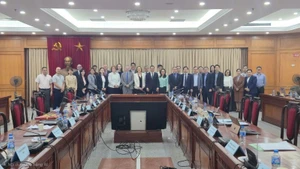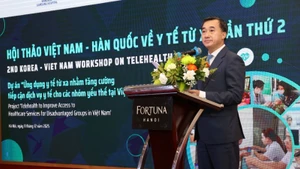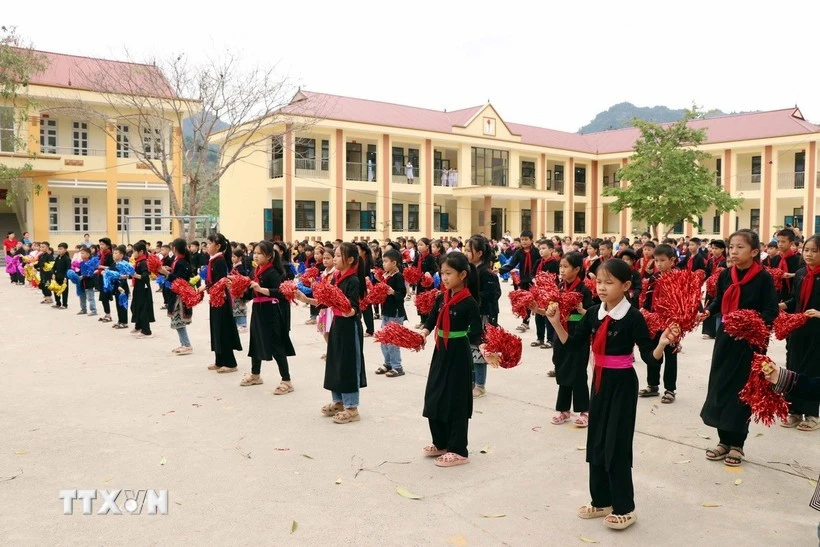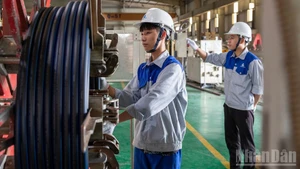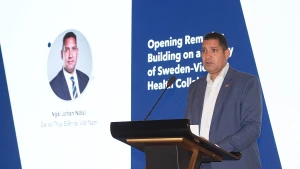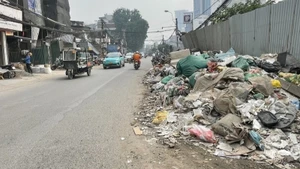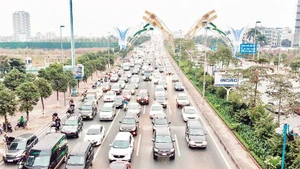In addition, the urban railway projects including Nhon-Hanoi Station in Hanoi and Ben Thanh-Suoi Tien in Ho Chi Minh City are also urgently being completed. The development of green transport modes is gradually replacing motor vehicles and will dominate big cities in the future.
People are excited about the new form of transportation
Nguyen Minh Phuong, a resident in Ha Dong district said that after several trials, she decided to buy a monthly ticket to travel regularly by overhead train, which helps her save time and petrol costs. The train runs smoothly, so she can work or rest on the train. In addition, there are 54 bus routes connecting to the Cat Linh-Ha Dong urban railway, including 16 bus routes at the first station of Cat Linh and the last station of Yen Nghia, including eight to nine bus routes at each intermediate station.
General Director of Hanoi Urban Metro (Hanoi Metro) Vu Hong Truong said that after more than four months of official commercial operation, the number of passengers travelling on the Cat Linh-Ha Dong route has increased more and more.
Trains carry an average of 10,000 passengers per day and about 15,000 per day on weekends. Particularly on Sunday, March 20, the number of passengers soared to nearly 21,000, up 30% compared to the previous months. The good news is that the number of passengers switching from one-way tickets to monthly tickets has surged sharply with 70% of passengers using monthly tickets at peak hours.
Along with the operation of the Cat Linh-Ha Dong urban railway, the traffic picture of the two big cities has become greener, when several electric bus lines and public bicycle services have also been put into operation. Vinbus Ecological Transport Service Company Limited under Vingroup has operated four electric bus routes in Hanoi and one in Ho Chi Minh City, receiving the support of the people.
The Ho Chi Minh City authorities decided to provide a subsidy for this electric bus route with a fare of 7,000 VND per passenger, the same as the normal bus fare. Vice-Chairman of Ho Chi Minh City People's Committee Le Hoa Binh said “Electric buses contribute to the achievement of the goal of reducing greenhouse gas emissions while changing people's habits to using green means of transport. The city will gradually transform the use of their bus vehicles using diesel fuel to clean fuel, helping to protect the environment”.
Ho Chi Minh City also launched a public bicycle service in December 2021to increase connectivity between modes of transport and promote tourism development. A representative of Tri Nam Group Joint Stock Company, the investor in the public bicycle service, said they saw more than 109,000 users with 124,000 hours of cycling, equivalent to 723,000 km after more than three months since its launch.
From the success of this model, the Hanoi People's Committee recently assigned the Hanoi Department of Transport to build a project developing public bicycle services in several downtown districts.
In the first phase of the project from 2022 to 2023, about 1,000 bicycles, including 500 traditional bicycles and 500 electric bicycles, will be arranged in 70-80 locations in the districts of Ba Dinh, Tay Ho, Dong Da and Thanh Xuan, in addition to the entrances and exits of the Cat Linh – Ha Dong urban railway line. In the second phase from 2023 to 2024, the project will be expanded to other districts with a total of 3,000 bicycles arranged at about 350 locations.
Overcoming barriers
Green transport is being promoted in Vietnam's big cities according to the roadmap, however, there remain some barriers that slow down this process, especially in terms of financial resources, technology, and mechanisms.
According to Vice Chairman of Hanoi People’s Committee Duong Duc Tuan, Hanoi will have ten urban railway lines and ring roads by 2030.Shortly, the Cat Linh-Ha Dong urban route will be extended to the Xuan Mai satellite urban area. However, large-scale projects such as urban railway lines face many difficulties due to the lack of mechanisms, policies, and capital, in addition to problems in land clearance and lack of qualified human resources.
For example, the Nhon-Hanoi Station urban railway line has been under construction for more than ten years, but only 74% of the project has been completed, mainly due to the lack of cleared land for underground construction. Hanoi is trying to complete the elevated section from Nhon to Cau Giay to be put into operation by the end of 2022.
Similarly in Ho Chi Minh City, the Ben Thanh-Suoi Tien urban railway line has also been under construction for more than ten years. Despite the city’s efforts, the completion time of this route has been delayed several times due to obstacles and it is expected to be put into commercial operation in 2023.
Head of the Ho Chi Minh City Urban Railway Management Board Bui Xuan Cuong said that about 88.9% of the project has been completed and13 out of 17 trains were transported to Long Binh depot, Thu Duc City, to prepare for the trial operation. However, the progress of the project is still behind schedule.
Deputy Head of the Hanoi Urban Railway Management Board Le Trung Hieu said that the actual construction of the Nhon- Hanoi Station line reveals the lack of mechanisms and policies suitable for this type of project. It is necessary to be well prepared for four conditions, including planning, land clearance, capital, and human resources, to speed up the construction of large projects such as urban railway projects.
Bui Xuan Cuong commented that the promotion and mobilisation of investment capital for urban railway projects, especially investment from the private sector or the use of commercial loans, remains low and yet to meet actual needs amid limited budget resources. In addition, the management and implementation of urban railway projects encounter many problems, including complicated procedures, the continuous adjustment of project progress, and slow capital disbursement, leading to poor capital efficiency. To solve these limitations, central ministries and agencies need to support the city to build mechanisms and policies to attract investors and mobilise all resources to focus on urban railway development.
In addition to investment in infrastructure construction, the awareness of traffic participants is also very important. Vice President of the Hanoi Union of Science and Technology Associations, Bui Thi An said “We need to actively disseminate the information so that people are aware of the benefits of green transport while limiting the use of personal vehicles”.
City authorities should focus on building pedestrian streets and encouraging people to walk or use bicycles, electric vehicles and mass transit vehicles using clean energy, such as electric trains and electric buses to promote the efficiency of modern passenger transport modes for building a green transport system, An noted.
